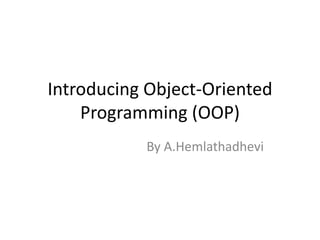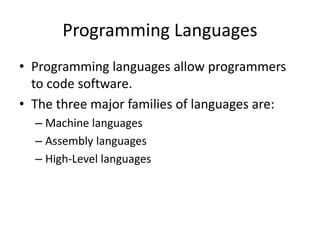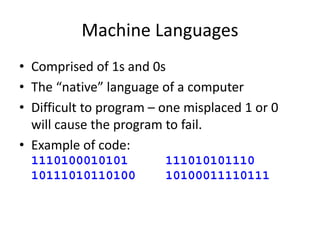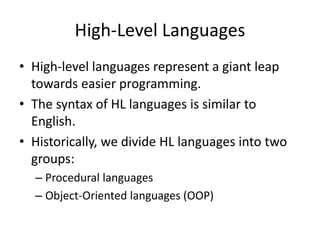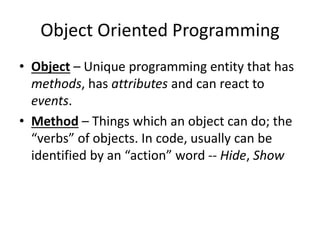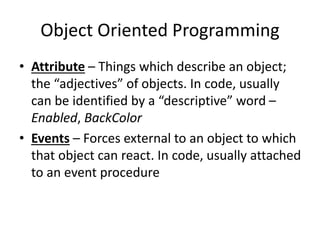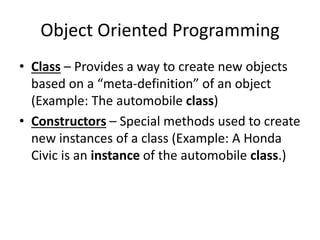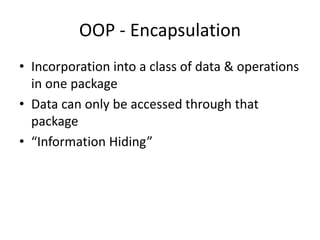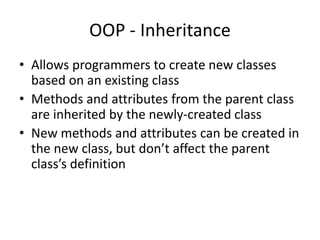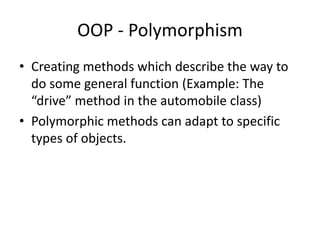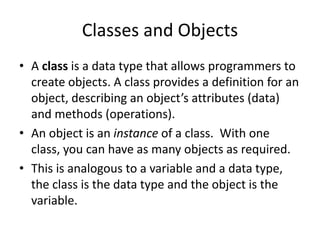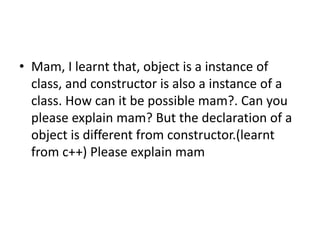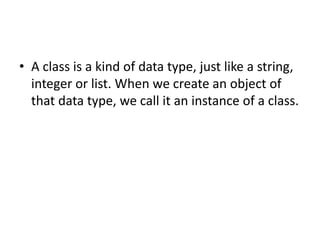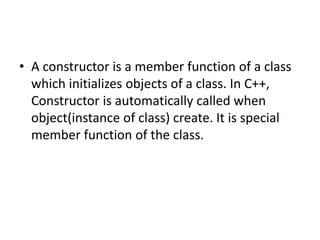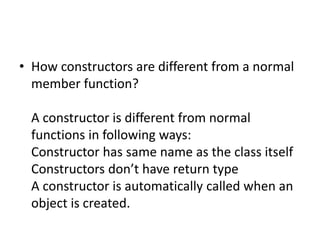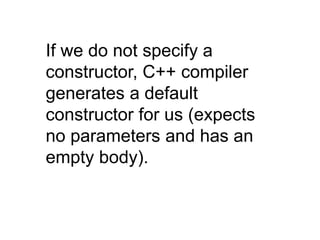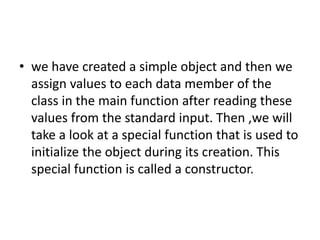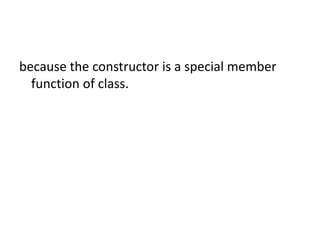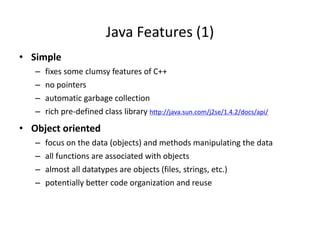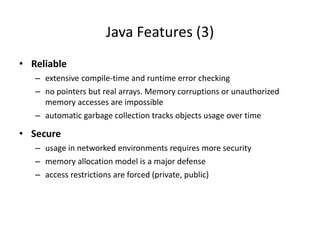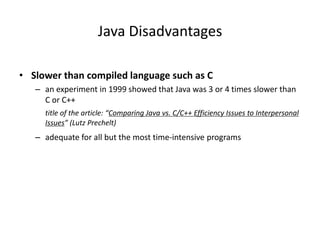Introducing object oriented programming (oop)
- 1. Introducing Object-Oriented Programming (OOP) By A.Hemlathadhevi
- 2. Programming Languages ŌĆó Programming languages allow programmers to code software. ŌĆó The three major families of languages are: ŌĆō Machine languages ŌĆō Assembly languages ŌĆō High-Level languages
- 3. Machine Languages ŌĆó Comprised of 1s and 0s ŌĆó The ŌĆ£nativeŌĆØ language of a computer ŌĆó Difficult to program ŌĆō one misplaced 1 or 0 will cause the program to fail. ŌĆó Example of code: 1110100010101 111010101110 10111010110100 10100011110111
- 4. Assembly Languages ŌĆó Assembly languages are a step towards easier programming. ŌĆó Assembly languages are comprised of a set of elemental commands which are tied to a specific processor. ŌĆó Assembly language code needs to be translated to machine language before the computer processes it. ŌĆó Example: ADD 1001010, 1011010
- 5. High-Level Languages ŌĆó High-level languages represent a giant leap towards easier programming. ŌĆó The syntax of HL languages is similar to English. ŌĆó Historically, we divide HL languages into two groups: ŌĆō Procedural languages ŌĆō Object-Oriented languages (OOP)
- 6. Procedural Languages ŌĆó Early high-level languages are typically called procedural languages. ŌĆó Procedural languages are characterized by sequential sets of linear commands. The focus of such languages is on structure. ŌĆó Examples include C, COBOL, Fortran, LISP, Perl, HTML, VBScript
- 7. Object Oriented Programming ŌĆó Object ŌĆō Unique programming entity that has methods, has attributes and can react to events. ŌĆó Method ŌĆō Things which an object can do; the ŌĆ£verbsŌĆØ of objects. In code, usually can be identified by an ŌĆ£actionŌĆØ word -- Hide, Show
- 8. Object Oriented Programming ŌĆó Attribute ŌĆō Things which describe an object; the ŌĆ£adjectivesŌĆØ of objects. In code, usually can be identified by a ŌĆ£descriptiveŌĆØ word ŌĆō Enabled, BackColor ŌĆó Events ŌĆō Forces external to an object to which that object can react. In code, usually attached to an event procedure
- 9. Object Oriented Programming ŌĆó Class ŌĆō Provides a way to create new objects based on a ŌĆ£meta-definitionŌĆØ of an object (Example: The automobile class) ŌĆó Constructors ŌĆō Special methods used to create new instances of a class (Example: A Honda Civic is an instance of the automobile class.)
- 10. OOP - Encapsulation ŌĆó Incorporation into a class of data & operations in one package ŌĆó Data can only be accessed through that package ŌĆó ŌĆ£Information HidingŌĆØ
- 11. OOP - Inheritance ŌĆó Allows programmers to create new classes based on an existing class ŌĆó Methods and attributes from the parent class are inherited by the newly-created class ŌĆó New methods and attributes can be created in the new class, but donŌĆÖt affect the parent classŌĆÖs definition
- 12. OOP - Polymorphism ŌĆó Creating methods which describe the way to do some general function (Example: The ŌĆ£driveŌĆØ method in the automobile class) ŌĆó Polymorphic methods can adapt to specific types of objects.
- 13. Classes and Objects ŌĆó A class is a data type that allows programmers to create objects. A class provides a definition for an object, describing an objectŌĆÖs attributes (data) and methods (operations). ŌĆó An object is an instance of a class. With one class, you can have as many objects as required. ŌĆó This is analogous to a variable and a data type, the class is the data type and the object is the variable.
- 14. Thank you
- 15. ŌĆó Mam, I learnt that, object is a instance of class, and constructor is also a instance of a class. How can it be possible mam?. Can you please explain mam? But the declaration of a object is different from constructor.(learnt from c++) Please explain mam
- 16. ŌĆó A class is a kind of data type, just like a string, integer or list. When we create an object of that data type, we call it an instance of a class.
- 17. ŌĆó A constructor is a member function of a class which initializes objects of a class. In C++, Constructor is automatically called when object(instance of class) create. It is special member function of the class.
- 18. ŌĆó How constructors are different from a normal member function? A constructor is different from normal functions in following ways: Constructor has same name as the class itself Constructors donŌĆÖt have return type A constructor is automatically called when an object is created.
- 19. If we do not specify a constructor, C++ compiler generates a default constructor for us (expects no parameters and has an empty body).
- 20. ŌĆó we have created a simple object and then we assign values to each data member of the class in the main function after reading these values from the standard input. Then ,we will take a look at a special function that is used to initialize the object during its creation. This special function is called a constructor.
- 21. because the constructor is a special member function of class.
- 22. ŌĆó 3 classs
- 23. What is java? ŌĆó Developed by Sun Microsystems (James Gosling) ŌĆó A general-purpose object-oriented language ŌĆó Based on C/C++ ŌĆó Designed for easy Web/Internet applications ŌĆó Widespread acceptance
- 24. Java Features (1) ŌĆó Simple ŌĆō fixes some clumsy features of C++ ŌĆō no pointers ŌĆō automatic garbage collection ŌĆō rich pre-defined class library http://java.sun.com/j2se/1.4.2/docs/api/ ŌĆó Object oriented ŌĆō focus on the data (objects) and methods manipulating the data ŌĆō all functions are associated with objects ŌĆō almost all datatypes are objects (files, strings, etc.) ŌĆō potentially better code organization and reuse
- 25. ŌĆó Interpreted ŌĆō java compiler generate byte-codes, not native machine code ŌĆō the compiled byte-codes are platform-independent ŌĆō java bytecodes are translated on the fly to machine readable instructions in runtime (Java Virtual Machine) ŌĆó Portable ŌĆō same application runs on all platforms ŌĆō the sizes of the primitive data types are always the same ŌĆō the libraries define portable interfaces Java Features (2)
- 26. Java Features (3) ŌĆó Reliable ŌĆō extensive compile-time and runtime error checking ŌĆō no pointers but real arrays. Memory corruptions or unauthorized memory accesses are impossible ŌĆō automatic garbage collection tracks objects usage over time ŌĆó Secure ŌĆō usage in networked environments requires more security ŌĆō memory allocation model is a major defense ŌĆō access restrictions are forced (private, public)
- 27. Java Features (4) ŌĆó Multithreaded ŌĆō multiple concurrent threads of executions can run simultaneously ŌĆō utilizes a sophisticated set of synchronization primitives (based on monitors and condition variables paradigm) to achieve this ŌĆó Dynamic ŌĆō java is designed to adapt to evolving environment ŌĆō libraries can freely add new methods and instance variables without any effect on their clients ŌĆō interfaces promote flexibility and reusability in code by specifying a set of methods an object can perform, but leaves open how these methods should be implemented ŌĆō can check the class type in runtime
- 28. Java Disadvantages ŌĆó Slower than compiled language such as C ŌĆō an experiment in 1999 showed that Java was 3 or 4 times slower than C or C++ title of the article: ŌĆ£Comparing Java vs. C/C++ Efficiency Issues to Interpersonal IssuesŌĆØ (Lutz Prechelt) ŌĆō adequate for all but the most time-intensive programs

